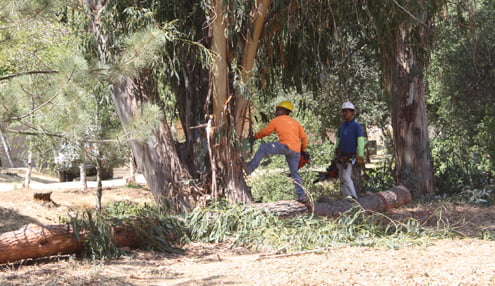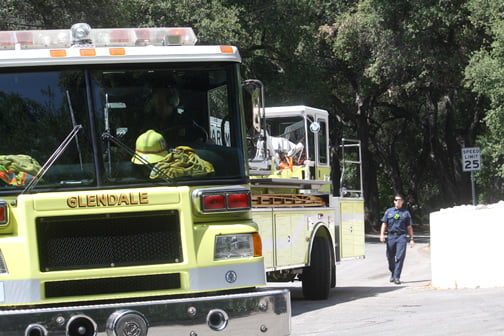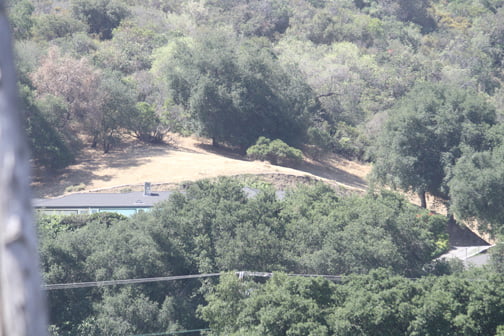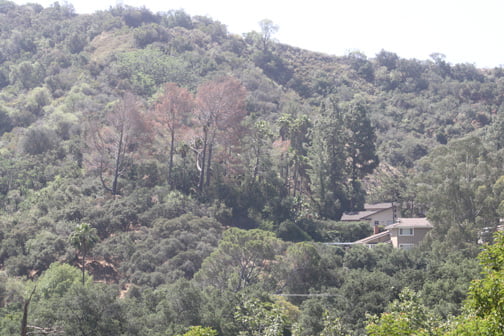With a fire season that is year-round, officials are requesting help from residents to cut back nearby brush and vegetation from their homes.

Workers cut away dead vegetation at Camp Max Straus in the Verdugo Mountains. The camp workers have been diligently working on abatement at the location to be proactive in the fight against wildfires.
By Mary O’KEEFE
There is no debate that Crescenta Valley, in fact all of California, is dry. Rainfall is down, vegetation is drying out and summer is ramping up.
A reminder of how dry the local vegetation is came on May 30 at 3:30 p.m. For those in Crescenta Valley, there were eerily familiar images as the Powerhouse Fire climbed up the hills of the Angeles National Forest and evacuations were announced. A daily update was given on the fire’s progress. In the end, the Powerhouse Fire burned 30,274 acres and, as of Monday, was 95% contained, according to inciweb.org.
The fire was fueled by heavy, old growth chaparral brush, similar to what fed the Station Fire.
Dry vegetation and low humidity levels are always a warning sign that residents should be fire-ready and fire-aware. In a recent ride-along with Glendale Fire Dept., the CVW spoke with firefighters from Station 29 about abatement, the dry vegetation and how to be proactive when it comes to fire prevention.
“Currently we are three months ahead [in dry vegetation and humidity levels] of what we would be normally, “ said Capt. Carlos Guerro. “Normally we would see these levels in August and September.”
Humidity levels help indicate how dry vegetation is. Low levels are always of concern, but in an area like Crescenta Valley that is surrounded by wild vegetation, it is even more of an issue. Once ignited, wildfires can spread quickly with embers traveling miles. Add Santa Ana winds to that recipe and it can be a disaster. Glendale and Los Angeles County fire departments have sent out notices to local residents warning them of the dangers of not being fire-prepared and requiring brush be cut back at hillside homes.

“The first letter was sent to abate on May 1. [Residents] were to have their [property] cleared by June 1,” Guerrero said. Abatement is one the best defenses residents can give firefighters to help them control a fire.
As engineer Brett Mason drove the fire engine through local neighborhoods, Guerrero pointed out homes that had heeded the abatement request and a few that had not.
“See that home,” he pointed out. “All the vegetation is cleared.”
The home, high on a hill in Whiting Woods, had an obvious cleared space of at least 100 feet surrounding the residence. As Guerrero walked through the neighborhood, he pointed out another home that, although it was not up against the open land, had a large pile of wood that lined two sides of the home.
“This home is one we will come back to,” Guerrero said.
Residents were sent a letter requesting abatement, allowing the homeowner 30 days to comply. If they do not comply, then the County of Los Angeles will get involved and send workers out to clear the area. The county workers are typically more expensive than anyone the resident might hire.
“We give them the month of May, then start going out to [properties] in June,” Guerrero said.
October used to be known as fire season, but since the drought and continuing low humidity, fire season is more year-round.
The coming months have historically had low amounts of precipitation.
“As far as your area, it is pretty dry,” said Stuart Seto, weather specialist with the National Weather Service, Oxnard.
Three-fourths of the area’s rain comes in the latter part of the year, he added. In June, precipitation is normally .22 inches, July is .05 inches and August is .11 inches. The rain totals are based on a 30-year average.
“That’s not a lot of rain,” he said. “That is why [officials] are saying in May the fuels are so dry.”
The low live and dead fuel moistures, along with persistent drought, have created the potential for active to extreme fire behavior in many parts of the state, according to the predictive services of National Interagency Coordination Center.
The agency has declared a Fuels and Fire Behavior Advisory for the entire state of California finding that there is a deficiency in rainfall and snow pack resulting in fuels that are four to eight weeks ahead of normal drying rates.
The Glendale Fire Dept. has a Fire Prevention Bureau that can help residents with questions on what they can do to be proactive. For information, visit http://fire.ci.glendale.ca.us/fireprev.asap or contact (818) 548-4810. For Los Angeles County Fire, visit http://fire.lacounty.gov/SafetyPreparedness/ReadySetGo/home or contact (323) 881-2411.
In upcoming articles, CVW will cover abatement companies, and provide more information on how being fire ready will keep your neighborhood safe.


